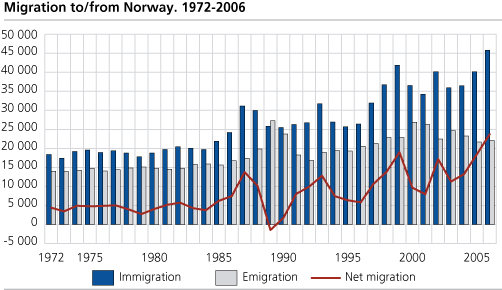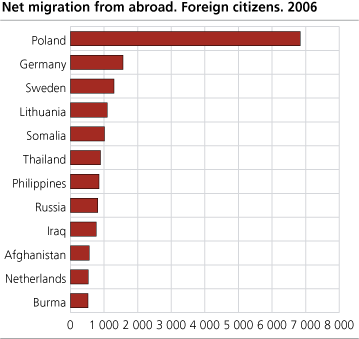Content
Published:
This is an archived release.
Highest net immigration ever
In 2006, 45 800 immigrations and 22 100 emigrations were registered. Thus net immigration was 23 700. This is an increase of 5 300 or almost 30 per cent since 2005. The average from the turn of the century prior to 2006 was 13 000.
Net immigration from countries in Europe made up the largest group, with 15 200 net immigrations, followed by Asia with 6 800. From the 1970s to 2005, net immigration from Europe mainly varied between 2 000 and 5 000, but increased to 9 400 in 2005 and 15 200 in 2006. The increase in net immigration from Poland since 2003 has been 6 700, and net immigration from Sweden, Lithuania and Germany has also increased. On the other hand, net immigration from Russia and Spain has decreased. Large net immigration in earlier years has been due to extraordinary situations resulting in many refugees.
As for the other continents, net immigration has been relatively stable in recent years, but there have been variations for individual countries. Net immigration from countries such as Afghanistan, Iraq, Iran and Somalia has decreased significantly, as has net immigration from Pakistan and Turkey. There has been an increase in net immigration from countries like the Philippines and Thailand, as well as from India.
Mostly Polish citizens
Polish citizens made up the largest group of immigrants (7 400), followed by Swedes (3 400) and Germans (2 300). Swedes made up the largest group of emigrants with 2 100, followed by Danes and Germans with 1 300 and 700 respectively. Polish citizens therefore had the largest net immigration with 6 800 (compared with 2 900 in 2005), followed by Germans and Swedes with 1 600 and 1 300 respectively.
Polish citizens settled in Oslo (1 300), Bergen (600), and also Bærum, Haugesund, Stavanger and Asker (between 400 and 300 each).
Because of the change from refugee to labour immigration, the share of men has increased from 49 to 55 per cent in later years, and the increase has been particularly marked in the age group 30-39 years.
Majority in Oslo - few in Finnmark
Oslo and Akershus had the highest number of immigrants with 10 800 and 5 600 respectively,
followed by Rogaland and Hordaland. Finnmark had the lowest number of immigrants. Rogaland and Akershus have seen the highest percentage increase in immigration compared with the period 2001-2005 - the increase in Rogaland was 52 per cent. Finnmark has seen a decrease of 26 per cent.
The share of Oslo’s net immigration has increased from 8 per cent of the total in 2003 to 17 per cent in 2006. Akershus and Rogaland's share of net immigration also increased strongly, whereas this decreased for other counties, most markedly Nordland. This is due to the change from refugee to labour immigration in later years.
Of Norway’s 431 municipalities, 429 had immigration and 404 had emigration. 387 had net immigration, 16 were in balance, whereas 28 had net emigration.
See also: Migration, Internal .
The statistics are also available in Statbank Norway .
Tables:
- Table 1 Immigration and emigration. 1951-2006
- Table 2 Immigration/emigration, by county. 1966-2006
- Table 3 Immigration, by country. 1966-2006
- Table 4 Emigration, by country. 1966-2006
- Table 5 Net in-migration, by country. 1966-2006
- Table 6 Immigration and emigration, by sex, age and marital status of migrants. 2006
- Table 7 Immigration and emigration, by sex and age of migrants. 2006
- Table 8 Immigration and emigration, by sex, age of migrants and county. 2006
- Table 9 Immigration and emigration, by citizenship, 2006
- Table 10 Immigration and emigration, by Norwegian/foreign citizenship and country of immigration/emigration. 2006
- Table 11 Immigration, by citizenship and region. 2006
- Table 12 Emigration, by citizenship and region. 2006
The statistics is published with Migrations.


